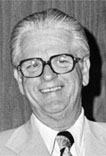 Dick O'Brien was Harley-Davidson's highly successful racing manager from 1957 to 1983. Under O’Brien's direction, Harley-Davidson factory riders won 16 AMA Grand National Championships. He also oversaw the development of the Harley-Davidson XR750, which became the most successful racing motorcycle ever to turn a wheel on the dirt-track ovals of America. In addition to dirt track and road racing, O'Brien also directed diverse Harley-Davidson racing programs such as motocross, desert racing and land-speed record attempts.
Dick O'Brien was Harley-Davidson's highly successful racing manager from 1957 to 1983. Under O’Brien's direction, Harley-Davidson factory riders won 16 AMA Grand National Championships. He also oversaw the development of the Harley-Davidson XR750, which became the most successful racing motorcycle ever to turn a wheel on the dirt-track ovals of America. In addition to dirt track and road racing, O'Brien also directed diverse Harley-Davidson racing programs such as motocross, desert racing and land-speed record attempts.
O'Brien was born in New York on July 8, 1921, and was raised in St. Petersburg, Florida. As a boy he began learning how to work on motors by watching older kids in the neighborhood who already owned cars. As a teenager, he sold fruit and picked up odd jobs and was able to scrounge up enough to buy an old junker car and, later, a motorcycle. He learned to work on cars and bikes at an early age and quickly earned a reputation as a top-notch mechanic.
Not content to just work on the motors, O'Brien took up racing and became quite good in sprint cars. For a time he also dabbled in racing motorcycles on half-mile and mile dirt ovals in Florida. But his real talent was making the bikes faster. O'Brien went to work for Puckett Motors Harley-Davidson dealership in Orlando. The shop was heavily involved in racing and O'Brien's reputation grew as motorcycles he built won numerous races across the South.
In 1957, Harley's racing manager, Hank Syvertsen, who had been with Harley-Davidson's racing department since the 1920s, hired O'Brien, and when Syvertsen retired later that year, O'Brien was made head of racing. O'Brien didn't let the change of climate from Florida to Milwaukee bother him. "I just wore warmer clothes and still rode my motorcycle year-round," O'Brien said proudly.
In the face of heavy competition, primarily from the British-made BSA and Triumph teams, Harley-Davidson dominated the late-1950s and early-1960s AMA Grand National Series with Carroll Resweber. O'Brien said that of all the riders who rode for Harley-Davidson, he felt that Resweber may have been the most talented. "He could do it all – on miles, half-miles, TTs and road racing," remembered O'Brien. "Resweber would try things that other riders would never attempt."
With riders such as Dick Mann, Gary Nixon and Kenny Roberts, the British and Japanese factory teams were overtaking Harley-Davidson, at first on the road courses and then even on the dirt tracks, which had been Harley's domain for the better part of 50 years. The company needed to improve on its venerable KR racers, and in the early-1970s, Harley-Davidson launched its new XR750 motor.
The new engine went through several years of teething problems, but under O'Brien's direction the XR was progressively improved and gradually grew to be a consistent winner. By the mid-1970s, Harley-Davidson was again atop the AMA Grand National Series and the XR750-based racing machines would go on to become the winningest dirt track motorcycle in the history of the series.
O'Brien, known as OB to friends, is described by those who worked with him as somewhat cantankerous, smart and determined. He always sported his trademark black and orange Harley-Davidson clothing at the races and, despite his hatred of losing, was gracious in defeat. In 1968, the Harley team suffered a disheartening and unexpected loss of the title at the last event of the season at Ascot Park. A Motorcyclist magazine article said that Harley-Davidson factory rider Freddie Nix was reduced to tears by the loss, but O'Brien, face impassive, simply said, "Damn, I would have liked to have had that sonofabitch," meaning the championship, then walked over and was one of the first to congratulate new champ Gary Nixon.
O'Brien oversaw Harley-Davidson's motocross and desert racing programs, though he rarely attended those events, leaving the day-to-day management of those series to subordinates. In 1970, O'Brien coaxed another of his favorite riders, Cal Rayborn, into climbing inside the streamlined Harley-Davidson land-speed entry at the Bonneville Salt Flats in Utah. After suffering several high-speed crashes, Rayborn broke through and earned Harley-Davidson a new land-speed record of 265.492 mph.
O'Brien retired from Harley-Davidson in 1983. He went on to work for 11 years developing winning engines in NASCAR before retiring to his native Florida in the mid-1990s.
Of all his racing memories, O'Brien says that the 1968 Daytona 200 was one that stands out. That year, facing the onslaught of both British and Japanese factory racing teams, the Harley-Davidson squad breathed new life into the old KR design and came out and dominated Bike Week.
"That first lap, when the top six Harley’s came around the banking with a big lead on the rest of the field, that image will always be with me," O'Brien fondly recalled. "Cal (Rayborn) went on to win that race by a lap and a half and was the first to average over 100 mph for the race."
Dick wasn’t the only one from the O'Brien clan to make a mark in racing. His brother, Jess, helped form the Battle of the Twins racing class and his daughter, Patty, was a co-founder of the WERA road racing organization.
Dick O’Brien was inducted into the AMA Motorcycle Hall of Fame in 2000. He died in 2003.